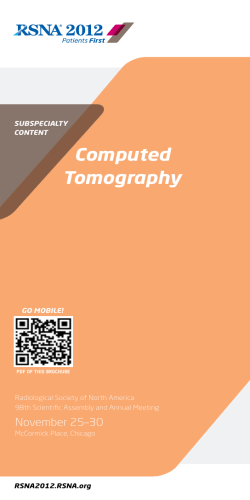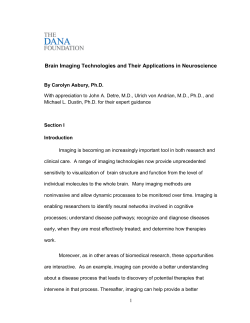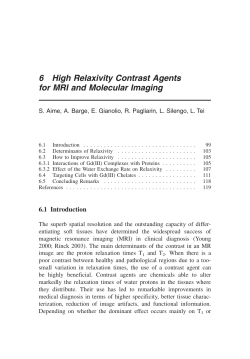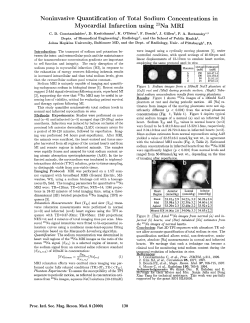
Document 6093
!
Medical Science Series
THE PHYSICS OF
MEDICAL IMAGING
Edited by
Steve Webb
Joint Department of Physics,
Institute of Cancer Research and
Royal Marsden Hospital, Sutton, Surrey
Adam Hilger, Bristol and Philadelphia
'\
6.4 RADIONUCLIDES
FOR IMAGING
One of the primary advantages associated with the use of radionuclides
in medicine is the large signal (in this case the emitted radiation)
obtained from the relatively small mass of radionuclide ~J1lployedfor a
given study, Nuclear medicine takes advantage of this physical characteristic by using various radioisotope-tagged compounds (radiopharmaceuticals) in order to 'trace' various functions of the body
(McAfee and Thakur 1977). The minute mass of radio labelled material
allows for non-invasive observation without disturbance of the system
under study through pharmacological or toxicological effect. For most
nuclear medicine studies, the mass of tracer used is in the range of
nanograms (see table 6.4), and no other physical technique could be
employed to measure mass at these levels. Therefore, the sensitive
measurement of biochemical and physiological processesthrough the use
of radioactivity and its detection comprise the fundamental basis of
nuclear medicine and is the key to its future growth.
182
The physics of radioisotope imaging
Table 6.4 Approximate mass (g) of 37 GBq (1 Ci) of radionuclide
for a given half-life and atomic weight.
Atomic weight of atom (amu)
TI/2
-"
18
15 s
15 min
6h
8d
15 a
2.4
1.4
3.5
1.1
7.7
x
x
X
X
X
99
10-11
10-9
10-8
10-6
10-4
1.3
7.7
1.9
6.3
4.2
X
X
X
X
X
10-10
10-9
10-7
10-6
10-3
201
2.7
1.6
3.8
1.2
8.3
X
X
X
X
X
10-10
10-8
10-7
10-5
10-3
6.4.1 Radioactive decay
The radioactivity
Q of a nu,!Ilber (N) of nuclei is given by
Q
=-
AN
= dN Idt
(6.13)
where A is defined as the decay copstant for the radioisotope. We can
see that the rate of decay of nuclei depends only upon A and the number
of nuclei, N. The solution to equation (6.13) is
N=Noexp(-At)
where No is the number of nuclei at some reference time t
(6.14)
= O. If
T 1/2
is the time for half the nuclei to decay, the so-called 'half-life', then
TI/2 = (In2)/A.
(6.15)
An alternative form of equation (6.14) is
N = No(~)m
(6.16)
where m is the number of half-lives since the reference time t = O.
Using these simple equations, it is possible to calculate the radioactivity of any mass of nuclei at any time subsequent to a measurement at a
reference-zero time.
6.4.2 The production of radionuclides
The fundamental property of all radioactive elements is the imbalance of
the proton-to-neutron ratio of the nucleus. A proper balance of proton~
and neutrons is essential for maintaining a stable atomic nucleus. The
balance must be maintained to overcome electrostatic repulsion of the
charged protons, and figure 6.48 shows how the neutr{)n-to-proton (nip)
ratio changes with increasing mass. There are four ways by which
radionuclides are produced:
(a)
(b)
(c)
(d)
neutron capture (also known as neutron activation);
nuclear fission;
charged-particle bombardment; and
radionuclide generator.
Radionuclidesfor imaging
183
120
"f'
t,;-
.,."
~~:"
100
!,
c:
~- 80
Ii:
~ 60
,;;"
.li:";;::-
lso~
E
"'5 40
lsoba~
.{r
.i'Iso1upes
~
.it"i'
2
,,-'
40
Proton
Figure
Graph
6.48
of neutron
60
number,
80
p
number
n versus
proton
number
p,
showingthe increasein the nip ratio with atomicnumber.
Each method affords useful isotopes for nuclear medicine imaging. A
description of the methods and examples of some of the useful radioisotopes produced will now be presented.
Neutron capture is the absorption of a neutron by an atomic nucleus,
and the production of a new radionuclide via reactions such as
n +
n +
To
produce
must
have
best-suited
The
for
most
through
sample
reaction
radioactive
a mean
of
with
means
of
yield
element
depends
through
and
eV.
the
flux
y
(6.17)
(6.18)
neutron
These
absorption
producing
reactor.
is placed
on
+
+ p.
32p
of 0.03-100
use of a nuclear
a target
99Mo
elements
energy
interaction
efficient
the
32S -
98Mo
into
radioisotopes
To
produce
in a field
density
capture,
'thermal'
the
'by
atomic
this
a radioactive
of thermal
of
incident
neutrons
neutrons
are
nucleus.
method
is
species,
neutrons.
particles,
a
The
cJ>
(cm-2s-1), the number of accessible target nuclei (nJ and the likelihood or cross section of the reaction, a (barn). The yield (Ny) is given
by
ntcJ>a - exp( -At)].
Ny = -;:-[1
(6.19)
The radionuclide produced via the (n,y) reaction is an isotope of the
target material, i.e. the two nuclei have the same number of protons.
This means that radionuclides produced via the (n,y) reaction are not
carrier-free (compare with nuclear fission), and thus the ratio of
radioactive atoms to stable atoms and the specific activity are relatively
low. Separation of the radionuclide from other target radio nuclides is
possible by physical and chemical techniques. Useful tracers produced
by neutron absorption are shown in table 6.5.
Nuclear fission is the process whereby heavy nuclei (235U, 239pU,237U,
184
The physics of radioisotope imaging
232Th)irradiated with thermal neutrons are rendered unstable due to
absorption of these neutrons. Consequently, these unstable nuclei
undergo 'fission', the breaking up of the heavy nuclei into two lighter
nuclei of approximately similar atomic weight, for example
!n ~ 236
235
92U + U'.
92U ~ 99
42Mo + 133
50Sn + 41n
0 .
(620)
.
As seen from equation (6.20), this reaction produces four more neutrons, which may be absorbed by other heavy nuclei, and the fission
process can continue until the nuclear fuel is exhausted. Interaction such
as that in equation (6.20) must, of course, conserve Z and A.
Table 6.5 Radionuclides produced by neutron absorption.
Gamma-ray
energy
(keV)
Isotope
51Cr
59Fe
99Mo
1311b
320
,1099
740
364
-
Half-life
Absorption
cross section
(barn)
27.7d
44.5d
66.02 h
8.05 d
17"
1.1"
0.13
0.2
" From BRH (1970).
b 130Te(n,y)131Te
1311.
Nuclides produced by fission of heavy nuclei must undergo extensive
purification in order to harvest one particular radionuclide from the
mixture of fission products. The fission process affords high specific
activity due to the absence of carrier material (non-radioactive isotope
of the same element). However, fission products are usually rich in
neutrons and therefore decay principally via {3- emission, a physic~l
characteristic that is undesirable for medical imaging, but of interest in
therapy. Useful nuclides produced by nuclear fission are shown in table
6.6.
Table6.6 Radionuclidesproducedby nuclearfission.
Isotope
Gamma-ray
energy
(keV)
Half-life
Fission
yield"
(%)
740
364
81
662
66.02h
8.05d
5.27d
30 a
'6.1
2.9
6.5
5.9
99Mo
1311
133Xe
137CS
" From BRH (1970).
Radionuclides for imaging
185
Charged-particle bombardment is the process of production of
radionuclides through the interaction of charged particles (H:t, D + ,
3He2+, 4He2+) with the nuclei af stable atoms. The particles must have
enough kinetic energy to overcome the electrostatic repulsion of the
positively charged nucleus. Two basic types of accelerator are used for
this purpose, the linear accelerator and the cyclotron. In both systems,
charged particles are accelerated over a finite distance by the application
of alternating electromagnetic potentials (figure 6.49). In both types of
machine, particles can usually be accelerated to various energies.
Examples of typical reactions in a target are
p + 68Zn ~
a + 160 ~
67Ga
18F
+ 2n
(6.21)
+ P + n.
(6.22)
(al
Ion source
acuum
hamber
Acc
bea
t
~
)
~
ACvoltage
'II
(b)
Drift tubes
Ion
.,-c'I:J's"EZJ...Ei;J",='.=~"=""'1
source
-+-+-+-+-+-+-+-+-+
Target
~diofrequency cavities
Figure6.49 Schematicdiagramsof (a) a cyclotron and (b) a linear
acceleratorfor radionuclideproduction.
(' For the production of medically useful radionuclides, particle energies
per nucleon in the range 1-100 MeV are commonly used. One major
advantage of producing isotopes through charged-particle bombardment
is that the desired isotope is almost always of different atomic number
to the target material. This theoretically allows for the production of
radio nuclides with very high specific activity and minimal radionuclide
186
The physics of radioisotope imaging
impurity. However, the actual activity and purity obtained is related to
the isotopic and nuclidic purity of the target material, the cross section
of the desired reaction and the cross section of any secondary reaction.
Charged-particle reactions yield radionuclides that are predominantly
neutron-deficient
and therefore decay by (3+ emission or electron
capture. The latter radioisotopes are particularly useful for clinical
imaging due to the lack of particulate
emission. Examples of
accelerator-produced radionuclides routinely used in nuclear medicine
are shown in table 6.7.
Table 6.7 Radionuclides produced by charged-particle bombardment.
Isotope
tiC
13N
ISO
18F
67Ga
Principal
gamma-ray energy
(keV)
1231
511 (fJ..+)
511 (fJ+)
511 (fJ+)
511 (fJ+)
93
184
300
171
245
159
201Tl
68-80.3
lllln
Half-life
20.4 min
9.96 min
2.07 min
109.7min
78.3 h
Reaction
14N(p,CX)IIC
13C(p,n)13N
15N(p,n)150
180(p,n)18F
68Zn(p,2n)67Ga
67.9 h
112Cd(p,2n)lllln
13 h
124Te(p,2n)1231
73 h
203Tl(})',3n)201
Ph 2olTI
1271(p,5n)123Xe~ 1231
Radioactive decay can lead to the generation of either a stable or a
radioactive nuclide. In either case, the new nuclide may have the same
or different atomic number depending on the type of decay (see next
section). Radioactive decay leading to the production of a radioactive
daughter with a different Z allows for the possibility of simple chemical
separation of the parent-daughter combination. If the daughter
radio nuclide has good physical characteristics compatible with medical
imaging and the parent has a sufficiently long half-life to allow for
production, processing and shipment, then remote parent-daughter
separation means a potentially convenient source of a medically useful
short-lived radionuclide. This type of radionuclide production system is
known as a radionuclide generator.
A radionuclide generator is a means of having 'on tap' a short-lived
radionuclide. It is technically achieved by the chemical separation of the
daughter radionuclide from the parent. This can be accomplished
through the use of chromatographic techniques, distillation or phase
partitioning. However, chromatographic techniques have been the most
Radionuclides for imaging
187
widely explored and are the current state-of-the-art technology (Yano
1975) for the majority of generator systemsin use today (figure 6.50).
Elutingsolution
in~t needle
Eluantoutj)Jt
needle
0.22~mfilter
Lead
shielding
ChromoiUQmphic
adsorbenT
Plastic
housing
Figure6.50 Schematicof a radioisotopegenerator.
The equations governing generator syst~msstem from the formula
Az =,
AZ
,
(6.23)
0
A,j[exp(
-A1t) - exp( -Azt)]
/l.z - /1.1
where A Y is the parent activity at time t
= 0, t is the time sincethe last
elution of the generator, A z is the activity of the daughter product
(A~ = 0), and Al and AZ are the decay constants of parent and daughter
radioisotopes, respectively.
For the special case of secular equilibrium, defined by AZ»A1, we
have
-J
Az
= AY[exp(-A1t) -
exp(-Azt)].
(6.24)
If t is much less than the half-life of the parent, In(2)/A1, and greater
than approximately seven times the daughter half-life, In(2)/Az, then
Az = AY.
(6.25)
This is the equilibrium condition. The growth of the daughter here is
given by
Az = AY[1 - exp(-Azt)].
(6.26)
For transient equilibrium, defined by AZ> Al but AZ not very much
greaterthan AI, we have
Az = AzA~/(AZ- AI).
(6.27)
-
Figure 6.51 shows the growth of 99Tcm activity in a 99Mo
generator.
99Tcm
188
The physics of radioisotope imaging
1.
Elutiontime
Parent
tivity
05
0.2
~0.10
>=
:;:
~
0.0
O.
0
12
24
36
48
Time(h)
Figure 6.51 The build-ue of activity of the daughter product with
time for a typical (99Mo/99Tcm)radioisotope generator.
The most widely used generator-produced
radionuclide in nuclear
medicine is 99Tcm. The parent, 99Mo, has a half-life of about 66 h, can
be produced through neutron activation or fission, can be chemically
adsorbed onto an Al2O3 (alumina) column and decays to 99Tcm (85%)
and 99Tc (15%). 99Tcm has a half-life of 6.02 h, decays to 99Tc by
isomeric transition and emits a 140 ke V y-ray (98%) with no asspciated
particulate radiations:
99Mo
-
99Tcm
p-
-
99Tc +
y.
(6.28)
IT
In the early days of their development (see Chapter 1), technetium
generators were sometimes referred to as 'radioactive cows'. The 99Tcm
is 'milked' from the chromatographic column of alumina by passing a
solution of isotonic saline through the column (0.9% NaCI). This saline
solution and the solid phase of Al2O3 allow for efficient separation of
99Tcmfrom the 99Mo with only minute amounts of 99Mo breakthrough
(less than 0.1%). The eluted 99Tcmcan be chemically manipulated so
that it binds to a variety of compounds, which will then determine its
fate in vivo (see §6.9). Other generator systems exist producing
radionuclides useful for gamma-camera imaging as well as for PETand
examples of these are given in table 6.8.
6.4.3 Types of radioactive decay
All radionuclides used in nuclear medicine are produced via one of the
four ways described above. Each of these radio nuclides has a unique
process by which it decays. The decay scheme describes the type of
decay, the energy associatedwith it and the probability for each type of
decay. These decay schemes can be very complex since many of the
radionuclides decay via multiple nuclear processes(figure 6.52).
c
L"
;i
~,
w
Radionuclidesfor imaging
189
Table6.8 Generator-produced
radionuclides.
Parent
P
Parent
halflife
Mode of
decay
P-+D
Mode of
Daughter decay
D
of D
Gamma-ray
Daughter energyfrom
halfdaughter
life
(keV)
,
99Mo
2.7 d
f3-
,99Tcm (
IT
6h
140
1.3 min
82Sr
25 d
EC
82Rb
68Ge
280 d
EC
68Ga
EC
f3+
EC
68 min
777
511
511
52Mnm
f3+
EC
21 min
511
13 s
9.8 min
190
511
9.5 min
93
52Fe
8.2 h
EC
f3+
81Rb
62Zn
4.7 h
9.1 h
EC
EC
81Krm
62CU
f3+
IT
IT
EC
178W
21.5 d
f3+
EC
178Ta
f3+
EC
1311
Emitted
photon
energies
(MeV)
0.723
0.667
0,637
l11 18
17 15 13
~4
0.405
0.364
0.341
19
16 14 12
0.164
110
Stable
0.080
11
131Xe
Figure6.52 The nucleardecayprocessfor 1311.
Alpha decay is the process of spontaneous emission of an a-particle (a
helium nucleus) in the decay of heavy radioisotopes, with a discrete
energy in the range 4-8 Me V. If a decay leaves the nucleus in an
--
190
The physics of radioisotope imaging
excited state, the de-excitation will be via the emission of y-radiation.
Most of the energy released in the transition is distributed between a
daughter nucleus (as recoil energy) and the (X-particle (as kinetic
energy). In the (X-decayprocess, the parent nucleus loses four units of
mass and two units of charge. As an example we show
2~Ra~ 2~Rn+ (x.
(6.29)
Although (X-emitting nuclides have no use in medical imaging (since
the (X-particles travel virtually no distance in tissue), there has been a
renewed interest in their use for targeted (i.e. highly localised) therapy.
As discussed previously, many radionuclides are unstable due to the
neutron/proton imbalance within the nucleus. The decay of neutron-rich
radionuclides involves the ejection of a {3--particle (e-), resulting in the
conversion of a neutron into a proton. Decay via {3- emission results in
the atomic number of the atom changing but the atomic weight
remaining the same. The energy of the emitted {3--particles is not
discrete but a continuum (i.e. varies from zero to a maximum, Em) and,
since the total energy lost by the nucleus during disintegration must be
discrete, an additional process must be responsible. Energy conservation
of {3 decay is maintained by the emission of a third particle-the
neutrino (v). The neutrino has no measurable mass nor charge, and
interacts weakly with matter. An example of {3- decay is
99Mo ~
99Tcm
+ e- + v.
(6.30)
Beta decay may be accompanied by y-ray emission if the daughter
nuclide is produced in an excited state. After {3- decay, the atomic
number of the daughter nuclide is one more than the parent nuclide, but
the atomic mass remains the same.
Nuclei that are rich in protons or are neutron-deficient may decay by
positron emission from the nucleus. This decay is also accompanied by
the emission of an uncharged particle, the anti neutrino (v). After
positron decay, the daughter nuclide has an atomic number that is one
less than that of the parent, but again the atomic weight is the same.
The range of a positron (e +) is short (of the order of 1 mm in tissue)
and, when the particle comes to rest, it combines with an atomic
electron from a nearby atom, and is annihilated. Annihilation (the
tr:;lnsformation of these two particles into pure energy) gives rise to two
photons both of energy 511 keV emitted approximately antiparallel to
each other. These photons are referred to as annihilation radiation.
Positron emission only takes place when the energy difference between
the parent and daughter nuclides is larger than 1.02 MeV. An example
of positron decay is
68Ga~ 68Zn + e+ + v.
(6.31)
An alternative to positron emission for nuclides with a proton-rich
nucleus is electron capture. Electron capture involves the absorption
within the nucleus of an atomic electron, transforming a proton into a
Radionuclides for imaging
191
neutron. For this process to occur, the energy difference between the
parent and the daughter nuclides can be small, unlike positron emission.
Usually the K-shell eleftrons are captured because of their closenessto
the nucleus. The vacancy created in the inner electron orbitals is filled
by electrons from the outer orbitals. The difference in energy between
these electron shells appears as an x-ray that is characteristic of the
daughter radionuclide. The probability of electron capture increaseswith
increasing atomic number because electron shells in these nuclei are
closer to the nucleus. An example of electron capture is
1231~
123Te
+ y.
(6.32)
A nucleus produced in a radioactive decay can remain in an excited
state for some time. Such states are referred to as isomeric states, and
decay to the ground state can take from fractions of a second to many
years. A transition from the isomeric or excited state to the ground state
is accompanied by y emission. When the isomeric state is long-lived, this
state is often referred to as a metastable state. 99Tcm is the most
common example of a metastable isotope encountered in nuclear
medicine (see equation (6.28».
Internal conversion is the process that can occur during y-ray emission
when a photon emitted from a nucleus may knock out one of the atomic
electrons from the atom. This particularly affects K-shell electrons, as
they are the nearest to the nucleus. The ejected electron is referred to
as the conversion electron and will have a kinetic energy equal to the
energy of the y-ray minus the electron binding energy. The probability
of internal conversion is highest for low-energy photon emission. Again,
vacancies in the inner orbitals are filled by electrons from the outer
shells, leading to the emission of characteristic x-rays. Furthermore,
characteristic x-rays produced during internal conversion may themselves
knock out other outer orbital electrons provided the x-rays have an
energy greater than the binding energy of the electron with which theyinteract. This emitted electron is then referred to as an Auger electron.
Again, vacancies in the electron shells due to Auger emission are filled
by other electrons in outer orbitals leading to further x-ray emission.
6.4.4 Choice of radioisotope for imaging
The physical characteristics of radionuclides that are desirable for
nuclear medicine imaging include:
(a) a suitable physi~~l half-life;
(b) decay via photon emission;
(c) associated photon energy high enough to penetrate the body
tissue with minimal tissue attenuation; but
(d) low enough for minimal thickness of collimator septa; and
(e) absenceof particulate emission.
The effective half-life T E of a radiopharmaceutical is a combination of
192
The physics of radioisotope imaging
the physical half-life T p and the biological half-life T B, i.e.
T1 =- T1 + -T1 .
-
E
B
(6.33)
P
Close matching of the effective half-life with the duration of the study is
an important dosimetric as well as practical consideration in terms of
availability and radiopharmaceutical synthesis.
The photon energy is critical, for various reasons. The photon must
be able to escape from the body efficiently and it is desirable that the
photopeak should be easily separated from any scattered radiation.
These two characteristics favour high-energy photons. However, at very
high energies, detection efficiency using a conventional gamma camera
is poor (see figure 6.5) and the increased septal thickness required for
collimators decreases the sensitivity further. In addition, high-energy
photons are difficult to shield and present practical problems for staff
handling the isotope.
The radionuclide that fulfils most of the above criteria is technetium99m (99Tcm), which is used in more than 90 % of all nuclear medicine
studies. It has a physical half-life of 6.02 h, is produced via decay of a
long-lived
(T 1/2
= 66 h)
parent 99Mo, and decays via isomeric transition
to 99Tcemitting a 140 keY y-ray. The short half-life and absence of f3:!:
emission results in a low radiation dose to the patient. The 140 keY y
emission allows for 50% penetration of tissue at a thickness of 4.6 cm
but is easily collimated by lead. Most importantly, the radioisotope can
be produced from a generator lasting the best part of a week, supplying
imaging agents 'on tap'.
Other radioisotopes in common use in nuclear medicine include 1231,
1111n,67Ga, 2olTI and 8lKrm. 1231has proved a valuable replacement for
1311as it decays via electron capture emitting a y-ray of energy 159 keY
and has a 13 h half-life. It is easily bonded to proteins and pharmaceuticals that can be iodinated. However, like most of the other
radioisotopes in this list, it is cyclotron-produced (table 6.7) and
presently still very expensive in a form free of other iodine isotopes.
The radionuclides 1IIIn and 67Gaare very similar chemically and both
decay via electron capture (table 6.9). Most recently, there has been an
increased interest in their use as antibody labels via bifunctional
chelates. III In is the superior imaging isotope, emitting acceptable
photon energies for gamma-camera studies, but again it is expensive as
it is produced by charged-particle bombardment (table 6.7). 67Ga has
long been used as a tumour localising agent in the form of gallium
citrate and has also proved useful in the same form in the detection of
abcesses.2OlTIis utilised by the cardiac muscle in a similar fashion to
potassium and is in widespread use for imaging myocardial perfusion.
However, the photon emissions used in myocardial imaging are the
80 keY x-rays, which are close in energy to lead x-rays produced by the
collimator, and this, together with the long half-life (73 h), makes the
isotope a poor imaging agent. Hence there is continued search for a
99Tcm-labelledmyocardial perfusion agent.
ao-
Radionuclides for imaging
193
Table 6.9 Main gamma emissions of 67Gaand IIIIn.
Gamma-ray
emission
Gamma-ray
energy
(keV)
67Ga
Y2
Y3
Ys
Y6
93
185
300
394
0.38
0.24
0.16
0.043
IllIn
YI
Y2
171
245
0.90
0.94
Radionuclide
Mean
number per
disintegration
~
Radioisotopes emitting positrons (table 6.7) have been used extensively for physiological research, in the main, rather than clinical nuclear
medicin~ because of the need for an on-site or nearby cyclotron to
produce them in view of~their relatively short half-lives. The radionuclides 15O, 13N, llC and 18F have many applications in the field of
functional imaging but have had little impact, as yet, in routine nuclear
medicine because of lack of availability. 68Ga and 82Rb, however, are
two generator-produced positron-emitting nuclides that could provide
invaluable radiopharmaceuticals for clinical PET.In particular, 68Gacan
be used to label many agents in a manner similar to 99Tcm,and 82Rbis
a greatly superior myocardial perfusion agent to 201TI.These radioisotopes, coupled with the development of low-cost PETcameras (§6.3.7),
may bring the much-needed advantages of high sensitivity and spatial
resolution to clinical nuclear medicine.
,
-
r
-,
© Copyright 2025





















